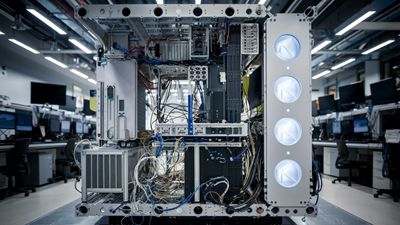Are Stock Analysts Bullish on Apple’s iPhone 16 Launch? An In-Depth Analysis
This report examines the sentiment of stock analysts regarding the launch of Apple’s iPhone 16, which was unveiled on September 9, 2024. The report aims to provide a comprehensive understanding of the factors driving the bullish or bearish sentiment among analysts, supported by facts, figures, and expert opinions.
Introduction
Market Context and Financial Performance
Declining iPhone Sales
Apple has been facing declining iPhone sales, with revenue slipping 1% to $39.3 billion in the last quarter. Sales in China, a crucial market for Apple, dropped by 6.5% to $14.73 billion. These figures have raised concerns among some analysts about the company’s ability to sustain its growth momentum.
Historical Stock Performance
Historically, Apple’s stock tends to underperform on the day of iPhone launches. For instance, Apple’s shares fell less than 1% on the day of the iPhone 16 launch, while the S&P 500 rose about 1%. This trend has been consistent, with Apple stock falling on 12 out of 17 iPhone launch days since 2013. Despite this, the stock often recovers within 30 to 60 days, as noted by Bank of America’s Wamsi Mohan.
Recent Stock Movements
Apple shares were marked 1.15% lower in premarket trading, indicating a potential opening price of $218.38, partly influenced by news of a $14.4 billion tax bill owed to the EU. The stock also dipped to a four-week low, falling 1.5% to $218 per share, following the iPhone 16 launch.
Analyst Opinions
Bullish Sentiment
Dan Ives (Wedbush)
Dan Ives from Wedbush remains optimistic, raising his price target for Apple shares from $285 to $300. He anticipates a renaissance in iPhone growth driven by AI features and a significant upgrade cycle, estimating sales could exceed 240 million units in FY25. Ives describes the iPhone 16 launch as potentially the most successful in Apple’s history.
Gene Munster (Deepwater Asset Management)
Gene Munster described the launch of Apple Intelligence as a “paradigm shift,” predicting that iPhone sales could grow by 5% to 6% in the next fiscal year. He believes that the integration of AI features will drive significant consumer interest and upgrades.
Wamsi Mohan (Bank of America)
Wamsi Mohan maintains a “Buy” rating on Apple, with a price target of $256, suggesting an 18% upside from its current levels. He emphasized that the iPhone 16 launch marks the beginning of a potentially multi-year software-driven upgrade cycle, driven by new AI features branded as “Apple Intelligence.”
Mixed Sentiment
Angelo Zino (CFRA)
Angelo Zino from CFRA maintained a buy rating but expressed disappointment over the lack of high-end pricing changes and limited details on AI rollout. While he acknowledges the potential for AI features to drive future sales, he remains cautious due to recent sales declines.
Ben Wood (CCS Insight)
Ben Wood highlighted the importance of the iPhone 16 in boosting sales amidst slowing consumer demand for smartphones. He remains cautiously optimistic but emphasizes the need for Apple to address declining sales in key markets like China.
Bearish Sentiment
Matt Farrell (Piper Sandler)
Matt Farrell viewed Apple’s decision to maintain stable pricing across its new models as beneficial, especially as consumer discretionary spending shows signs of weakness. However, he remains cautious about the immediate impact on sales, given the lack of significant price increases.
Product Features and Innovations
AI Integration
The iPhone 16 series introduces generative AI features branded as “Apple Intelligence.” These features include significant upgrades to Siri, new image and language generation tools, and functionalities like rewriting emails and summarizing notifications. Analysts believe that these AI features could drive a “golden upgrade cycle,” attracting existing users to upgrade their devices.
Hardware Improvements
The iPhone 16 series features the new A18 and A18 Pro chips, enhanced optical zoom up to 5x on Pro models, and improvements in camera capabilities. These innovations are aimed at attracting tech-savvy users and driving sales. The Pro model starts at $999, and the Pro Max starts at $1,199.
Competitive Pricing
Apple has maintained competitive pricing for the iPhone 16 models, starting at $799, the same as the iPhone 15 lineup in 2023. This strategy is seen as a way to increase the installed base of customers, which Apple retains well through its software and services integration.
Future Projections and Risks
Growth Projections
Morningstar forecasts a strong growth cycle for Apple in fiscal 2025, driven by the new AI features. They predict 10% iPhone revenue growth for fiscal 2025. Analysts from Morgan Stanley noted that the introduction of the AI-powered iPhone 16 could stimulate significant demand, with a potential upgrade cycle that could be the largest in Apple’s history.
Analyst Ratings
According to data from Visible Alpha, approximately 69% of analysts covering Apple have assigned “buy” ratings, while four analysts have a “hold” rating, and only one has issued a “sell” rating. The mean consensus price target for Apple stock is $244.06, indicating a potential 10.5% upside from its closing price of $220.82 on the previous Friday.
Risks and Challenges
Despite the optimistic projections, there are several risks and challenges that Apple faces. These include:
- Supply Chain Disruptions: Potential supply chain disruptions could affect the availability of the new iPhone models, impacting sales.
- Increased Production Costs: Rising production costs could affect profit margins, especially if Apple maintains stable pricing.
- Competitive Pressures: Apple faces intense competition from other smartphone manufacturers, which could impact its market share.
- Economic Factors: Economic factors, such as consumer discretionary spending and global economic conditions, could affect sales of premium electronics.
Conclusion
In conclusion, the sentiment among stock analysts regarding the launch of Apple’s iPhone 16 is generally bullish, driven by the integration of innovative AI features, strong financial performance, and positive growth projections. Analysts like Dan Ives and Gene Munster are particularly optimistic, raising their price targets and predicting significant sales growth. However, there are mixed opinions, with some analysts expressing caution due to recent sales declines and limited pricing changes.
Overall, while the iPhone 16 launch presents growth opportunities for Apple, investors should consider both the potential rewards and associated risks when evaluating the stock. The integration of AI features and competitive pricing strategies are expected to drive consumer interest and upgrades, contributing to a positive outlook for Apple’s future performance.


